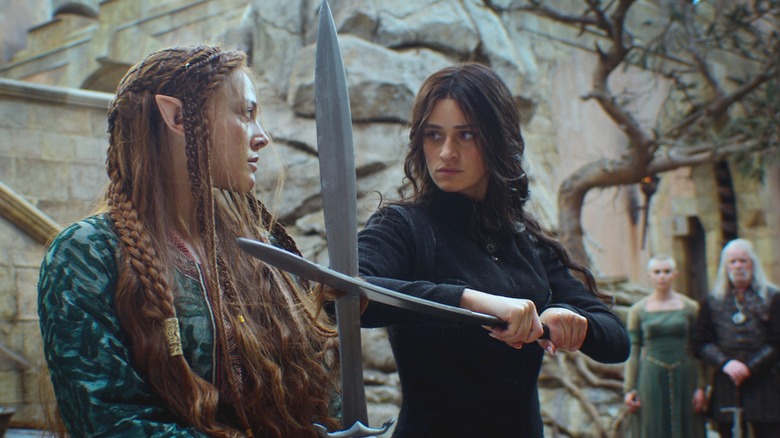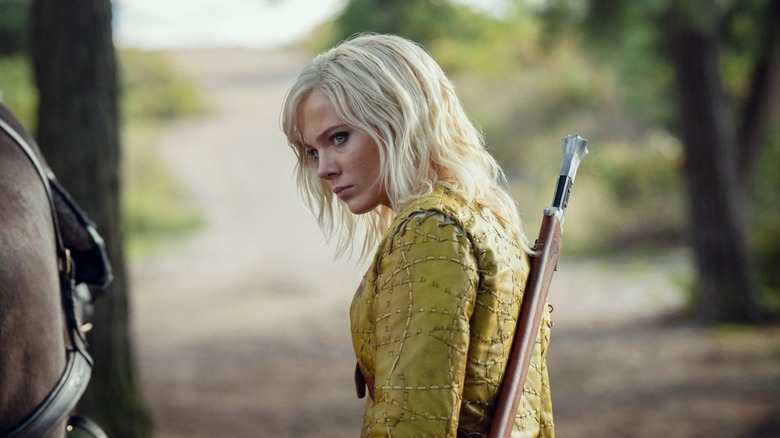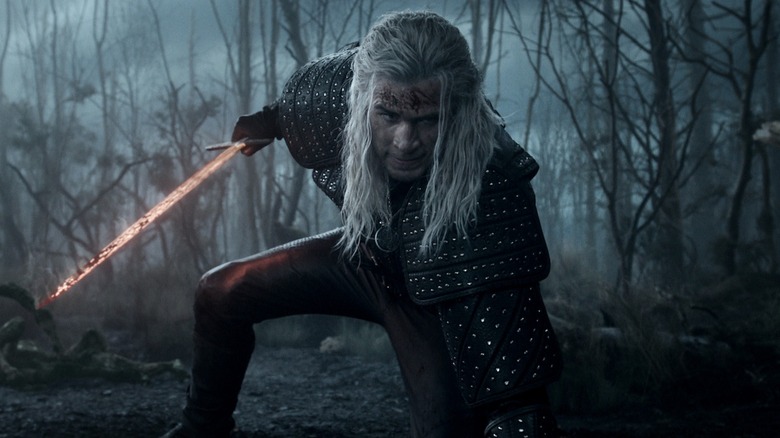Netflix’s “Witcherverse” has at all times been riddled with issues. For starters, the present’s makes an attempt to adapt Andrzej Sapkowski’s “The Witcher” novel collection have been inconsistent in high quality, with bursts of admirable originality usually overshadowed by drab, uninspired writing. Lauren Schmidt Hissrich’s collection struggled to seek out its footing within the first two seasons, however season 3 promised an thrilling new path that mixed Sapkowski’s intricate worldbuilding with the variation’s burgeoning id. Whereas Henry Cavill’s exit (as Geralt of Rivia) on the finish of season 3 forged some doubts on season 4’s roadmap, issues obtained again on monitor with Liam Hemsworth slipping into the footwear of our beloved witcher.
This offered season 4 with the distinctive alternative to begin contemporary, which ought to’ve labored in tandem with the borrowed goodwill from the earlier season and the astounding legacy of “The Witcher” franchise. Sadly, season 4 of the Netflix adaptation consistently flits between praiseworthy moments and monumental blunders, and this uneven high quality extends to nearly each side of the present. This utter lack of uniformity is regarding, because it bleeds into dialogue/performances as nicely — one second, you are moved by an emotional confession, and within the different, each phrase uttered feels disconnected from Sapkowski’s unusual and fantastical world.
I need to emphasize the truth that the brand new season’s shortcomings don’t have anything to do with Hemsworth’s portrayal of Geralt, as there aren’t any deliberate makes an attempt to change or reinvent the character. Hemsworth does a effective job of carrying the witcher’s medallion (extra on that later), and the apparent distinctions on this rendition aren’t essentially detrimental to the story. Season 4’s largest issues lie in its poor understanding of Sapkowski’s work, which robotically invalidates any try and undermine canon or steer away from it.
Season 4 of The Witcher makes some egregious, indefensible modifications to canon
The most recent season opens with a helpful recap, which eases us again into Geralt travelling alongside Jaskier (Joey Batey) and Milva (Meng’er Zhang), who’re on their option to Nilfgaard. Sapkowski’s “Baptism of Fireplace” units up this journey as a harmful one, and the collection faithfully replicates that in essence, albeit with far much less tact or nuance. On the flipside, we now have Yennefer (Anya Chalotra) portalling throughout the Continent searching for highly effective allies, which culminates in an inevitable confrontation with the conniving Vilgefortz (Mahesh Jadu) at Montecalvo. In the meantime, the top aim of Geralt and Yen’s determined efforts, Ciri (Freya Allan), has now taken the moniker of Falka, having embraced a violent, morally-dubious existence alongside the Rats.
Because the collection weaves these threads collectively, main modifications are made to canon. Now, no adaptation value its salt is a 1:1 recreation of its supply materials, because it must forge its personal id within the course of. However “The Witcher” season 4 makes some inexcusable choices by way of character fates: main characters are killed off means too early and robbed of their narrative function, and integral character moments are transposed for no cause in any way. Nothing in Sapkowski’s novels occurs in a vacuum, as each motion is tied to the destiny of the Continent, which is at the moment embroiled in battle. But, season 4 presents key occasions as remoted incidents with out dissecting their impression on a socio-political scale, resulting in a defanged interpretation of canon.
Montecalvo was by no means meant to be an indestructible stronghold, however this contemporary growth appears promising at first, because it affords Yennefer and her mage allies a compelling likelihood to destroy Vilgefortz and rebuild what they’ve misplaced after Aretuza’s fall. Whereas the climactic conflict feels kinetic in bits and items, it comes at the price of the advanced motivations that the Lodge of Sorceresses embody within the books (and in Projekt CD Crimson’s “The Witcher 3: Wild Hunt”). Everybody from Francesca (Mimî M. Khayisa) to Philippa (Cassie Clare) all of a sudden feels one-dimensional, as their actions are fully divorced from the political maneuvering established within the earlier seasons.
The deserves of Witcher 4 are regrettably marred by its inconsistent storytelling
Not the whole lot about this season is irritating. Whereas the Rats storyline is not exempt from poor writing moments, the emotional heft of this arc in the end pays off because it accomplishes what it units out to do. Ciri is meant to be unrecognizable this season, as she is the farthest from the princess Geralt discovered on the fringe of Brokilon. Allan has constantly been a standout, and he or she carries this mantle with real verve on this new chapter, the place we see Ciri’s humanity erode and nearly be erased over time. The crux of this arc is Leo Bonhart (Sharlto Copley), who embodies the chillingly unpredictable villainy that his ebook counterpart has at all times been identified for. Whereas we do not see a lot of Bonhart, the finale places him in Ciri’s proximity to etch a traumatic turning level for our character.
Season 4 additionally excels in monster design, bringing numerous beasts to life with out strictly adhering to the franchise’s canonical bestiary. Surprisingly, this facet works, paving the trail for some glorious combat choreography that can also be complemented by respectable monster lore (a few of which genuinely tug on the heartstrings). Mournful wraiths make houses out of graveyards, and tragic entities hang-out the Ysgith swamp — these moments remind us why “The Witcher” appeals to our thirst for fantasy tropes inside a grounded backdrop within the first place.
A slew of recent characters are launched, together with the kind-hearted Regis (Laurence Fishburne), the shrewd Skellen (James Purefoy), and the boisterous Zoltan (Danny Woodburn). These iterations are serviceable sufficient, regardless that they’re severely flattened by the story (the one exception being Skellen, due to Purefoy’s dynamic efficiency). There are additionally glimmers of brilliance right here, particularly in a quick animated sequence that spells out an origin story so vivid and multifaceted that you just would possibly begin questioning whether or not “The Witcher” has at all times been higher suited to a non-live-action medium.
Liam Hemsworth’s Geralt needs to be the least of your considerations with regards to The Witcher
Acclimating to a brand new model of a personality might be tough, however Hemsworth’s Geralt does not stick out like a sore thumb, at the least from a tonal standpoint. If something, he is a lot nearer to the bodily description of Geralt within the books/video games, sporting a extra agile preventing type that leverages a lean, muscled physique. When it comes to emotionality, this Geralt is supposed to be extra open, as this transformation already takes place on the finish of season 3, the place Geralt sheds his guarded neutrality.
This implies much less grunting and one-word quips, the place he wants to increase belief to a giant group of allies, together with these like Cahir (Eamon Farren), who’ve wronged Ciri previously. Hemsworth does an excellent job of balancing Geralt’s vicious physicality along with his ongoing emotional flux, which permits the character to develop and evolve with the narrative.
That mentioned, the collection’ writing discrepancies mirror on each character, together with Geralt, and the way we understand him. For this reason he is compelling in some scenes and fully unconvincing in others — this additionally extends to his quick companions, who alternate between eliciting endearment and annoyance. Furthermore, only a few performances really feel cohesive this season, however exceptions embody Bart Edwards’ Emhyr (who’s now consumed by corrupted overreaching) and Graham McTavish’s Dijkstra (who’s criminally under-utilized and sidelined). Even Chalotra’s Yennefer falls prey to this lack of cohesion, the place she’s seen channelling a vibrant cocktail of feelings into one scene and showing fully disengaged from her quick circumstances within the subsequent.
“The Witcher” units up some main ebook moments ultimately, however the impression of those acquainted stakes feels boring, like a weapon that hasn’t been sharpened in ages. The potential inherent in Sapkowski’s world is immense, however the Netflix adaptation squanders it with season 4, which is the weakest entry within the franchise to this point. Perhaps we do have to toss a coin to the witcher, as we have left the Valley of Loads far, far behind.
/Movie Ranking: 5 out of 10
“The Witcher” Season 4 premieres on October 30, 2025, on Netflix.




